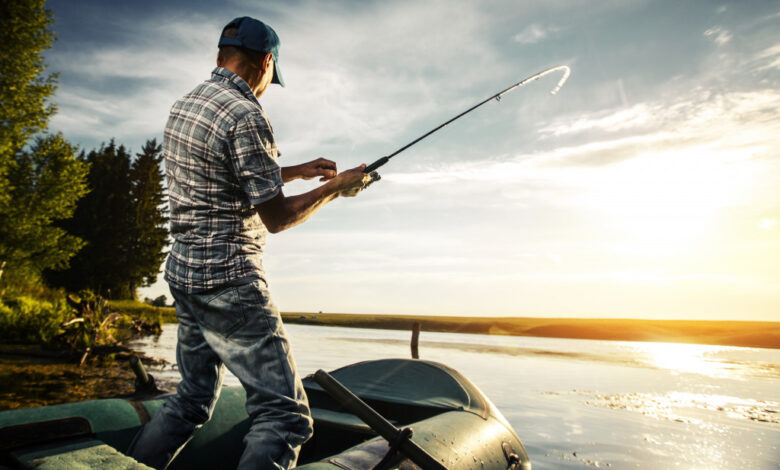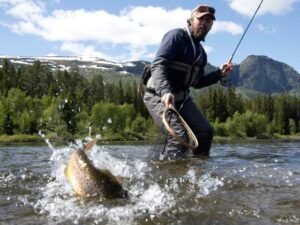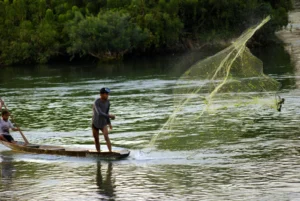Dive Into Fiskning: Your New Favorite Outdoor Hobby

Fiskning is a fun and exciting way to spend time outdoors. Fiskning, which means fishing, lets you relax by the water and enjoy the thrill of catching fish. Whether you are young or old, fiskning is a wonderful hobby that everyone can enjoy.
In this blog post, we will explore all the great things about fiskning. From the best places to fish to tips and tricks for beginners, you’ll learn everything you need to start your own fiskning adventure. Let’s dive in and discover the joy of fiskning!
What is Fiskning? A Simple Guide
Fiskning is all about catching fish using different methods like rods, nets, or traps. It’s a fun activity that people do near rivers, lakes, or even in the ocean. You can try it alone or with friends and family. The best part about fiskning is spending time outdoors and enjoying nature’s beauty.
To start fiskning, you need some basic gear like a fishing rod, bait (which can be worms or small fish), and maybe a net. First, you cast your line into the water and wait patiently for a fish to bite. When you feel a tug on your rod, that’s when you know you’ve caught something!
Many people enjoy fiskning because it’s relaxing and exciting at the same time. It’s not just about catching fish; it’s also about being in a peaceful environment and having fun with your loved ones. Whether you catch a big fish or just enjoy being outside, fiskning is a great way to spend your day.
The Best Places for Fiskning Near You
Finding the best places for fiskning depends on where you live. Lakes, rivers, and coastal areas are popular spots. Look for places that have clear water and where fishing is allowed. Local parks often have ponds stocked with fish, making them perfect for beginners.
Some people prefer fishing from a boat in the middle of a lake, while others like standing on the shore. Coastal areas offer a chance to catch bigger fish like cod or salmon. Researching local regulations can help you find the right spot and ensure you have a great fiskning experience.
If you’re not sure where to go, ask friends or family who enjoy fiskning. They might know secret spots or be able to recommend a good fishing spot nearby. Remember, the best place for fiskning is where you feel comfortable and can enjoy the outdoors.
Top Tips for Beginners in Fiskning
If you’re new to fiskning, here are some tips to help you get started. First, learn about the different types of fish in your area and what they like to eat. This will help you choose the right bait for your fishing trip. Patience is key in fiskning – sometimes fish don’t bite right away, so be prepared to wait.
Practice casting your line in an open area before you go fiskning. This will help you get used to how your rod feels and improve your accuracy. When you’re ready to fish, find a quiet spot away from distractions like loud noises or other people.
Check the weather forecast before you go fiskning. Sunny days with calm winds are ideal, but some fish like cloudy days too. Dress comfortably and bring snacks and water to stay hydrated. Finally, have fun and enjoy being outdoors – even if you don’t catch anything, fiskning is about the experience.
Fun Facts About Fiskning
Fiskning has a lot of interesting facts that make it unique. Did you know that the largest fish ever caught was a great white shark? It weighed over 2,000 pounds and was caught off the coast of Australia. Such records make fiskning an exciting and sometimes surprising activity.
There are many different types of fiskning. Fly fishing, for example, uses special lures that look like insects. Anglers cast these lures onto the water to attract fish. This technique requires skill and practice, making it a favorite among many fishing enthusiasts. Ice fishing is another unique method, where anglers drill holes in frozen lakes to catch fish beneath the ice.
Fiskning has its share of world records. The longest fishing rod ever made was over 50 feet long! Anglers around the world strive to break records for the biggest, smallest, or most unusual catches. These records add an element of fun and competition to the sport.
Why Fiskning is Great for Families
Fiskning is a wonderful activity for families to enjoy together. It’s a chance to bond while exploring nature and learning new skills. Children can learn patience and responsibility while adults can share their knowledge and experience. Fishing trips create lasting memories and provide opportunities for everyone to relax and have fun.
Families can plan fishing trips to local lakes or parks. Pack a picnic and spend the day fishing and enjoying the outdoors. Teach children about different fish species and how to handle them safely. Fishing promotes teamwork as family members help each other cast lines and reel in catches. It’s a wholesome activity that encourages communication and appreciation for the environment.
The Health Benefits of Spending Time Outdoors
Spending time outdoors has many health benefits for people of all ages. Fresh air and sunshine boost mood and energy levels. Outdoor activities like fiskning promote physical fitness and help reduce stress. Walking to fishing spots and casting lines engage muscles and improve coordination. Being in nature also encourages mindfulness and relaxation, contributing to overall well-being.
Outdoor activities support mental health by reducing anxiety and depression symptoms. Nature’s calming effects promote better sleep and cognitive function. Fishing requires focus and attention, stimulating brain activity and enhancing concentration. Overall, spending time outdoors through activities like fiskning promotes a healthy lifestyle and improves quality of life.
Essential Gear for a Successful Fishing Trip
Having the right gear is crucial for a successful fishing trip. A fishing rod and reel are essential tools for casting and reeling in fish. Choose a rod that matches the type of fishing you plan to do, whether it’s freshwater or saltwater. Fishing line should be strong and durable to withstand the weight of potential catches.
Bait and lures attract fish and increase chances of a successful catch. Live bait like worms or minnows is effective for many fish species. Artificial lures mimic insects or small fish and come in various shapes and colors. Tackle boxes organize gear and accessories like hooks, weights, and line cutters.
Appropriate clothing and footwear protect against weather conditions and ensure comfort during fishing trips. Sunglasses reduce glare from the water and protect eyes from harmful UV rays. A fishing license is required in many areas and ensures compliance with local fishing regulations. By investing in quality gear and preparation, anglers increase their chances of a rewarding fishing experience.
Different Types of Fish and Where to Find Them
Understanding different fish species and their habitats enhances fishing success. Freshwater fish like bass and trout thrive in lakes, rivers, and ponds. They prefer clear, cool water with plenty of cover such as rocks or submerged vegetation. Saltwater fish including snapper and grouper inhabit coastal areas and reefs.
Fish behavior changes with seasons and weather conditions. Spring and fall are prime fishing seasons as fish migrate and feed actively. Early morning and late afternoon offer optimal fishing times when water temperatures are favorable. Research local fishing reports and talk to experienced anglers for tips on where and when to find specific fish species.
Matching bait and lures to fish preferences increases chances of bites and successful catches. Fish near underwater structures and currents where they gather to feed. Patience and persistence pay off as anglers learn fish habits and improve fishing techniques over time. Exploring different fishing locations and experimenting with bait and lures enriches the fishing experience and broadens fishing skills.
Conservation Tips for Responsible Anglers
Responsible fishing practices help conserve fish populations and preserve natural habitats. Catch and release fishing allows fish to survive and reproduce, maintaining healthy populations. Use barbless hooks to minimize fish injury and facilitate safe release. Handle fish gently and keep them in the water as much as possible to reduce stress and ensure survival.
Observe fishing regulations and obtain necessary licenses to fish legally and ethically. Respect catch limits and size restrictions to prevent overfishing and maintain sustainable fish stocks. Avoid fishing in protected or restricted areas to protect vulnerable habitats and wildlife. Dispose of fishing line and trash properly to prevent environmental pollution and harm to wildlife.
Participate in community clean-up events and support conservation efforts to protect waterways and ecosystems. Educate fellow anglers and encourage sustainable fishing practices. Contribute to habitat restoration projects and advocate for responsible fishing practices. By practicing conservation ethics and stewardship, anglers ensure future generations can enjoy fishing and preserve natural resources for years to come.
The Joy of Cooking Your Catch
Preparing and cooking fresh-caught fish enhances the fishing experience and promotes culinary creativity. Clean fish thoroughly by removing scales and entrails before cooking. Fillet or cook fish whole based on personal preference and recipe instructions. Season fish with herbs, spices, and marinades to enhance flavor and appeal.
Grilling, baking, or frying fish produces delicious meals that satisfy and nourish. Serve fish with side dishes like vegetables, rice, or salads for a balanced and nutritious meal. Experiment with different cooking techniques and recipes to discover favorite flavors and preparations. Share meals with family and friends to celebrate fishing success and enjoy quality time together.
Eating fresh-caught fish provides essential nutrients like protein, vitamins, and omega-3 fatty acids that support overall health. Choose sustainable fishing practices to conserve fish populations and ensure future fishing opportunities. Enjoy the satisfaction of catching, preparing, and sharing delicious fish dishes that reflect the joy of fishing adventures.
Conclusion:
Fiskning is a fantastic way to have fun outdoors and connect with nature. Whether you’re catching fish with family or friends, or just enjoying the peacefulness of the water, fiskning offers something special for everyone. Remember, fiskning is more than just about catching fish—it’s about making memories and enjoying the beauty of the outdoors.
As you continue your fiskning journey, remember to respect nature and follow fishing regulations to help protect our environment. With the right gear, patience, and a love for adventure, you’ll discover the joy of fiskning and create wonderful stories to share. So, grab your fishing rod, find a great spot, and let the excitement of fiskning begin!





